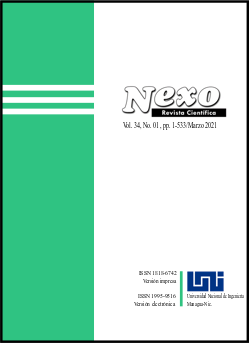Diseño y desarrollo de un modelo y planificación óptima para la responsabilidad de la cadena de suministro con el medio ambiente
DOI:
https://doi.org/10.5377/nexo.v34i01.11295Palabras clave:
logística inversa, inventario, emisiones de gases de efecto invernadero, consumo de energía, sostenibilidadResumen
La gestión responsable de los flujos de retorno de productos en entornos de producción e inventario es un requisito cada vez mayor para las empresas. Esto puede atribuirse a motivaciones económicas, ambientales y / o regulatorias. El modelado matemático de tales sistemas ha ayudado a los procesos de toma de decisiones y ha proporcionado una mejor comprensión del comportamiento de dichos entornos de producción e inventario. Este artículo revisa la literatura sobre el modelado de sistemas de inventario de logística inversa que se basan en la orden económica / cantidad de producción (EOQ / EPQ) y la configuración del tamaño de lote económico conjunto (JELS) para analizar sistemáticamente las matemáticas involucradas en la captura de las principales características de los procesos relacionados. La literatura se examina y clasifica de acuerdo con los problemas específicos que se enfrentan y los supuestos del modelo. Se presta especial atención a las cuestiones ambientales. Hay indicios de la necesidad de que las matemáticas de los modelos de logística inversa sigan las tendencias actuales en los modelos de cadena de suministro y inventario "ecológicos". La modelización de la eliminación de residuos, las emisiones de gases de efecto invernadero y el consumo de energía durante la producción se considera la prioridad más urgente para el futuro de los modelos de logística inversa. Se presenta un ejemplo ilustrativo para modelar modelos de inventario de logística inversa con implicaciones ambientales.
Descargas
1134
Descargas
Publicado
Cómo citar
Número
Sección
Licencia
Los autores que publican en Nexo Revista Científica están de acuerdo con los siguientes términos:
- Los autores conservan los derechos de autor y conceden a la revista el derecho de la primera publicación bajo la licencia Creative Commons Attribution License, que permite a otros compartir el trabajo con un reconocimiento a la autoría de la obra y a la publicación inicial en Nexo Revista Científica.
- Los autores pueden establecer por separado acuerdos adicionales para la distribución no exclusiva de la versión de la obra publicada en la revista (por ejemplo, en un repositorio institucional o en un libro) con el reconocimiento de su publicación inicial en Nexo Revista Científica.
- Se permite y se anima a los autores a difundir sus trabajos electrónicamente (por ejemplo, en repositorios institucionales o en su propio sitio web) antes y durante el proceso de envío, ya que puede dar lugar a intercambios productivos, así como a una citación más temprana y mayor de los trabajos publicados.










